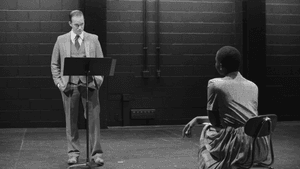Stay in the Loop
BSR publishes on a weekly schedule, with an email newsletter every Wednesday and Thursday morning. There’s no paywall, and subscribing is always free.
A brutal homecoming
Round House Theatre and McCarter present Adrienne Kennedy’s ‘Ohio State Murders’

McCarter Theatre Center and Round House Theatre continue their joint exploration of playwright Adrienne Kennedy with Ohio State Murders, a haunting work that draws upon the playwright’s own experiences as an undergraduate in the segregated Columbus of the 1940s and ‘50s. Despite a disappointing central performance, the production captures the beauty and horror that so often coexist in Kennedy’s plays, and it will hopefully bring this underseen contemporary classic to a wider audience.
A portrait of unequal existence
Ohio State Murders is the centerpiece of a suite of plays featuring the character Suzanne Alexander as an authorial avatar. Kennedy used Suzanne to explore topics that are ever-present in her body of writing, such as the impact of racism on American life and the realities of making a mark as a Black female writer. Yet although Kennedy sets this play at her alma mater—where Suzanne was once a student herself, and has returned to lecture on the violent imagery she regularly employs in her books—it is not necessarily autobiographical in the literal sense.
The title tragedy, for example, is fictional—and shouldn’t be revealed here. What it represents, however, is very real. Kennedy embeds the hour-long work with details of the unequal separation of Black and white students at the time, including that students of color were not permitted to declare an English major. Racism and stigma play their role in precipitating the play’s central event. In recounting a painful chapter of her past, Suzanne also offers a portrait of unequal existence that persists to this day.
Past and present
Kennedy often looks to the past in her plays, but here, it’s juxtaposed with the present. The current production, directed by Valerie Curtis-Newton and designed by Kelly Colburn, balances now and then with smart aesthetic choices. Scenes from Suzanne’s young adulthood are shot in dreamy black and white, with expert period costumes and a strong sense of memory encroaching upon the here and now. The role is split between Lynda Gravátt and Billie Krishawn, allowing the audience to chart the distance between 18-year-old Suzanne and today's Suzanne, an internationally renowned literary figure.
Here is where the trouble lies. Gravátt, a veteran actor I’ve seen give many fine performances, seems ill at ease carrying the balance of the play in Suzanne's long, sometimes hypnotic monologue. An overreliance on the script keeps her from fully connecting with the camera and often leaves the cadence of her narration sounding stilted. When Gravátt is comfortable, she’s terrific: a moment in which Suzanne recalls her begrudging choice to major in early childhood education after being denied by the English department conveys a still-burning sense of disappointment. But those instances are rare, and the play’s shattering conclusion comes across as perfunctory.
Riveting prose
In contrast, Krishawn becomes the production’s emotional center, fully communicating Suzanne’s youthful exuberance and her growing sense of internal conflict, particularly as she finds herself fascinated by a young, white academic (Rex Daugherty, who gradually, chillingly reveals the character’s malevolence). The proceedings are at their most vibrant in the flashbacks. Andrea Harris Smith, Heather Gibson, and Yao Dogbe round out the cast, filling in the details of Suzanne’s world memorably even when their roles are entirely wordless.
Ideally, there should be a stronger interplay between the central monologue and the events it depicts. But the riveting quality of Kennedy’s prose is never in question.
Image description: A black-and-white photo from a performance of Ohio State Murders. It shows two actors on an empty stage: a white man (actor Rex Daugherty) and a Black woman (actor Billie Krishawn). The man wears a light-colored suit and stands in front of a simple black paper-stand, looking skeptically at the woman, who is seated in front of him with her back to the camera. She has close-cut hair and wears a pleated dress.
What, When, Where
Ohio State Murders. By Adrienne Kennedy. Directed by Valerie Curtis-Newton. The Works of Adrienne Kennedy: Inspiration & Influence. McCarter Theatre Center and Round House Theatre. Streaming on demand through February 21, 2021. For more information, visit mccarter.org or roundhousetheatre.org.
Ohio State Murders is closed-captioned.
Sign up for our newsletter
All of the week's new articles, all in one place. Sign up for the free weekly BSR newsletters, and don't miss a conversation.

 Cameron Kelsall
Cameron Kelsall